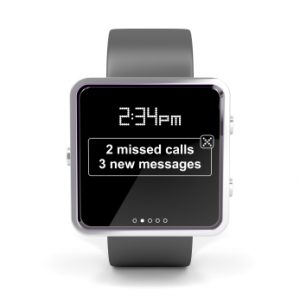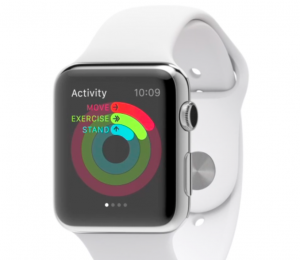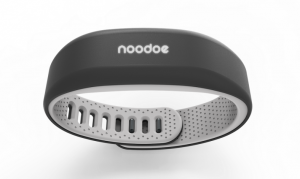Do you need a smartwatch?
The answer is a resounding no.
Not that anyone would necessarily believe they “need a smartwatch” to survive, but you don’t require one to keep up with the times either. Strictly speaking, all smartwatches are designed to offer convenience and that’s it — including the Apple Watch.
There are many things you can’t do with a smartwatch or wearable, or that you wouldn’t even want to do.
For instance, you’re not going to sit down and read a lengthy article on your smartwatch. You might save the URL with an app — which you can read on your smartphone later — but you almost certainly wouldn’t enjoy reading the entire piece on a small 2″ display.
Adversely, a wearable device that can track distance and calories burned probably can’t track your GPS location without a smartphone connected. In that case, if you wanted to track your run or bike route, you’d need to bring your phone. When you put it that way, most people begin to question carrying a smartwatch at all, and it makes sense since you can keep your smartphone instead.
So, wait? Why would anyone purchase a smartwatch then, especially the Apple Watch at $349?
Again, convenience.
You Don’t Need a Smartwatch, They’re Convenient
 It seems silly from the outset, but the most important smartwatch feature is actually one that compliments smartphones.
It seems silly from the outset, but the most important smartwatch feature is actually one that compliments smartphones.
When you have a smartwatch paired up with your smartphone you can receive calls, notifications, alerts and messages right on your wrist. This allows you to leave your phone in your pocket, on your desk or heck, even in your briefcase or handbag.
When all is said and done, you don’t need a smartwatch or a wearable.
If you’re the type of person who’s attached to your phone all day long, a smartwatch is a great investment.
On the other hand, if you’re the type of person that doesn’t feel the need to carry your smartphone at all times, a smartwatch is just unnecessary.
They Still Have Kinks
Every smartwatch on the market — yes even the Apple Watch — has its fair share of problems.
 Pebble recently announced their latest smartwatch — the Pebble Time — is having issues with iOS support. More specifically, Apple has taken longer testing the necessary software than expected which means it might launch without support for iPhones. Keep in mind, this is just one scenario there are plenty of others.
Pebble recently announced their latest smartwatch — the Pebble Time — is having issues with iOS support. More specifically, Apple has taken longer testing the necessary software than expected which means it might launch without support for iPhones. Keep in mind, this is just one scenario there are plenty of others.
The Apple Watch doesn’t work with older devices; only generation 5 iPhones and up are compatible. That means early iPhone adopters are left out in the cold, lest they spend the money to upgrade their phones.
The idea here is not to tear down smartwatches, but instead to be open and honest.
The issues become even more apparent when you look at the broad scope of the market. There are so many different types of wearables and smartwatches out there that things can get confusing fast — especially if you’re not a techie who happens to be up-to-date on all the latest technology trends.
Figure Out What You Want
If you’re still intent on getting a smartwatch or wearable after hearing all of that, you can move on to the next step. That’s easier said than done because choosing a smartwatch or wearable can be daunting.
To do so, you’ll need to figure out what it is you want from a wearable device.
Do you want it to track your runs or exercise routines? Do you want it so you can glance at notifications, alerts and messages at times you wouldn’t otherwise be able to? Does it need to be water-resistant or waterproof? Do you want a device that has access to mobile apps and customization options?
The features you need a smartwatch to include are going to determine which device you should consider for purchase — if you should even consider one at all.
Research Your Options
Once you’ve chosen a smartwatch or wearable, spend time researching it. Read reviews, and customer testimonials. Look at forums and message boards and pay attention to the questions people have had about the wearable. Have existing problems been solved by others already, are they things that would ruin your experience and is the product support team responsive?
Read reviews, and customer testimonials. Look at forums and message boards and pay attention to the questions people have had about the wearable. Have existing problems been solved by others already, are there things that might ruin your experience and is the customer support team for the product responsive?
![]() Don’t just settle with a single review — even one of ours. Branch out and read as many as you can, and pay attention to customer reviews specifically. It’s true that some can be a bit ridiculous, but they can still clue you in as to what kind of experience you’d get from the device.
Don’t just settle with a single review — even one of ours. Branch out and read as many as you can, and pay attention to customer reviews specifically. It’s true that some can be a bit ridiculous, but they can still clue you in as to what kind of experience you’d get from the device.
You might come across a review that says there are only three or four digital watchfaces available for a particular smartwatch, and this person is angry because they thought there were more. After reading this, you might find that you agree, or you might look at that and realize it doesn’t bother you as much. As shallow as that customer review may seem, it actually helped you in the decision process.
That’s why we recommend doing as much research as you can on a product.
Manage Your Expectations
We’re not telling you not to get excited about a product or what it can do. That’s perfectly natural and acceptable. However, buying something like a smartwatch and expecting it to solve every problem you have is… well, it’s completely unrealistic.
![]() Most wearables have been designed to solve one particular problem or question. You may find yourself lucky and realize the device you picked out is good for more than just one thing, but that’s not necessarily what you should expect from every wearable on the market.
Most wearables have been designed to solve one particular problem or question. You may find yourself lucky and realize the device you picked out is good for more than just one thing, but that’s not necessarily what you should expect from every wearable on the market.
A fitness band with no display is not going to allow you to see notifications or messages remotely. However, it might have an LED indicator that tells you something has arrived. In that case, you’ll need to whip out your phone to see what it is — whether it’s an email, text message or something else.
A smartwatch is meant to receive notifications and calls remotely, but not all of them can make calls. Worse yet, some of them have crippled functionality when they are not paired up with a smartphone. Don’t assume that every device on the market has the same functionality. When you’re doing your research ensure that the one you choose offers the features you want.
It seems silly to say, but it’s also important that you get clarification on those features. Don’t expect a smartwatch that says “remote call functionality” to be able to make calls on its own without a smartphone. Do some research and find out what that means.
The Smartwatch and Wearable Market Is Still Young
The smartwatch and wearable market is absolutely booming right now, it’s true. However, it’s still relatively young when compared to other areas of technology, like smartphones, which have collectively been around a lot longer.
 Companies are still working out the kinks with most of their products, and incremental updates are pretty common. Just look at Samsung, who already has a small handful of smartwatches on the market. Supposedly, they’re working on more as we speak!
Companies are still working out the kinks with most of their products, and incremental updates are pretty common. Just look at Samsung, who already has a small handful of smartwatches on the market. Supposedly, they’re working on more as we speak!
Some smartwatches features — like the market itself — are in their infancy. Particularly, when it comes to authentication, payment and health features those are still being ironed out behind the scenes. Apple Pay might be an innovative and neat thing to use, but it’s going to be a while before everyone can pay for lunch or dinner with their watch.
When all is said and done, you don’t need a smartwatch or a wearable. You probably already have a smartphone that you carry around on your person.
Will a wearable or smartwatch be convenient to you in some way? If not, then it’s not the time for you to buy one.

